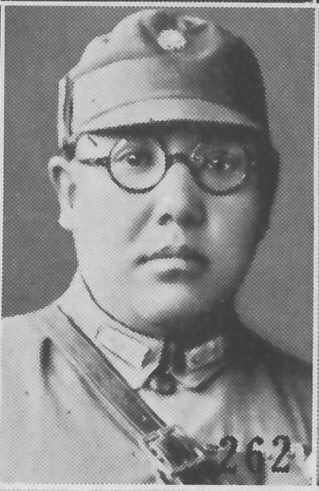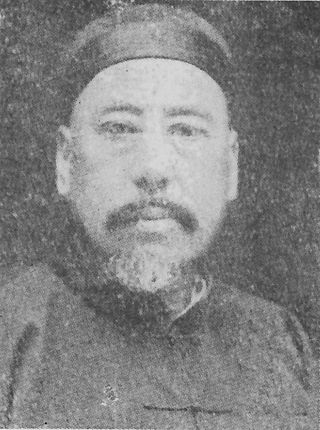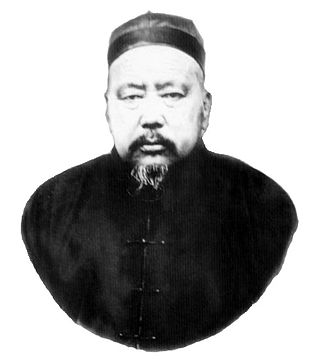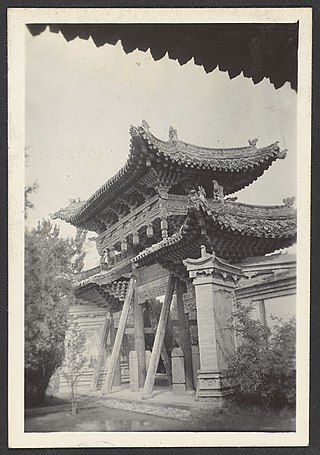The Guominjun, a.k.a. Nationalist Army, KMC, also called the Northwest Army (西北軍) or People's Army, refers to the military faction founded by Feng Yuxiang, Hu Jingyi and Sun Yue during China's Warlord Era.

The Central Plains War was a series of military campaigns in 1929 and 1930 that constituted a Chinese civil war between the Nationalist Kuomintang government in Nanjing led by Generalissimo Chiang Kai-shek and several regional military commanders and warlords who were former allies of Chiang.
The Ma clique or Ma family warlords is a collective name for a group of Hui warlords in Northwestern China who ruled the Chinese provinces of Qinghai, Gansu and Ningxia for 10 years from 1919 until 1928. Following the collapse of the Qing dynasty in 1912, the region came under Chinese Muslim warlord Ma Qi's control until the Northern Expedition by the Republic of China consolidated central control in 1928. There were three families in the Ma clique, each of them respectively controlled, parts of Gansu, Ningxia and Qinghai. The three most prominent members of the clique were Ma Bufang, Ma Hongkui, and Ma Hongbin, collectively known as the Xibei San Ma. Some contemporary accounts, such as Edgar Snow's, described the clique as the "Four Ma", adding Ma Bufang's brother Ma Buqing to the list of the top warlords. Other prominent Ma's included Ma Anliang, Ma Qi, Ma Lin, Ma Hu-shan, and Ma Zhongying.

Ma Hongkui was a prominent Muslim warlord in China during the Republic of China era, ruling the province of Ningxia. His rank was lieutenant general. His courtesy name was Shao-yun (少雲). In 1950, Hongkui migrated to the United States, where he lived until he died in 1970.

Ma Hongbin, was a prominent Chinese Muslim warlord active mainly during the Republican era, and was part of the Ma clique. He was the acting Chairman of Gansu and Ningxia Provinces for a short period.

Ma Lin was the governor of Qinghai 1931–38 and the brother of Ma Qi. A Muslim born in 1873, Linxia County, Gansu, he mainly acceded to the posts of his brother, being general of southeastern Gansu province, as well as councillor of the Qinghai provincial government and acting head of the Construction Bureau of Qinghai province. His father was Ma Haiyan.

Ma Qi was a Chinese Muslim General in early 20th-century China.

Ma Fuxiang was a Chinese Muslim scholar and military and political figure, spanning from the Qing Dynasty through the early Republic of China. His positions illustrated the power of family, the role of religious affiliations and the interaction of Inner Asian China and the national government of China. A prominent Muslim warlord in northwest China, Ma Fuxiang originally served under Dong Fuxiang, like other Ma Clique Muslim warlords such as Ma Anliang.

The Beijing Coup was the October 1924 coup d'état by Feng Yuxiang against Chinese President Cao Kun, leader of the Zhili warlord faction. Feng called it the Capital Revolution. The coup occurred at a crucial moment in the Second Zhili–Fengtian War and allowed the pro-Japanese Fengtian clique to defeat the previously dominant Zhili clique. Followed by a brief period of liberalization under Huang Fu, this government was replaced on November 23, 1924 by a conservative, pro-Japanese government led by Duan Qirui. The coup alienated many liberal Chinese from the Beijing government.

Ma Anliang was a Hui born in Hezhou, Gansu, China. He became a general in the Qing dynasty army, and of the Republic of China. His father was Ma Zhan'ao, and his younger brothers were Ma Guoliang and Ma Suiliang 馬遂良. Ma was educated in Chinese and Islamic education. His Muslim name was Abdul Majid.

Ma Wanfu, also known as Hajji Guoyuan (果园哈只), was a Dongxiang Imam of Guoyuan village (果园村) in Hezhou. He studied in Mecca and founded the Ikhwan movement in 1888, also known as the "New Sect", spreading in Gansu, Ningxia and Qinghai. He opposed Sufism.

Xidaotang --originally called Jinxingtang 金星堂, the "Gold Star Hall"; also called the Hanxue pai 汉学派, the "Han Studies Sect" —is a Sino-Islamic religious body / special economic community centered in Gansu province. The Xidaotang is mainly distributed in Lintan and Hezheng County in Gansu, and also has followers in Qinghai, Xinjiang, and Sichuan.
Tang Yanhe a Han chinese, was born Gansu, China. He commanded an army of Chinese Muslim soldiers along with Dong Fuxiang, and used them to crush the Muslim Rebellion of 1895.

The Dungan Revolt (1895–1896) was a rebellion of various Chinese Muslim ethnic groups in Qinghai and Gansu against the Qing dynasty, that originated because of a violent dispute between two Sufi orders of the same sect. The Wahhabi inspired Yihewani organization then joined in and encouraged the revolt, which was crushed by loyalist Muslims.

Ma Qixi, a Hui from Gansu, was the founder of the Xidaotang, a Chinese-Islamic school of thought.

The Kuomintang Islamic insurgency was a continuation of the Chinese Civil War by Chinese Muslim Kuomintang Republic of China Army forces mainly in Northwest China, in the provinces of Gansu, Qinghai, Ningxia, and Xinjiang, and another insurgency in Yunnan.
The Bai Lang Rebellion was a Chinese "bandit" rebellion lasting from mid 1913 to late 1914. Launched against the Republican government of Yuan Shikai, the rebellion was led by Bai Lang. His rebel army was an eclectic mix of anti-Yuan Shikai troops and rebels, bandit groups and Gelaohui members. As a unit, they were allied to southern Guangdong based revolutionaries.
Ma Haiyan (1837–1900) was a Chinese Muslim general of the Qing Dynasty. Originally a rebel, he defected to Qing during the Dungan revolt and helped crush rebel Muslims.

Ma Zhongying, also Ma Chung-ying, nickname Commander Ga, was a Hui Chinese Muslim warlord during the Warlord era of China. His birth name was Ma Buying. Ma was a warlord of Gansu Province in China during the 1930s. His alliance with the Kuomintang (KMT) brought his predominantly Chinese Muslim troops under the control of the KMT as the New 36th Division with Ma Zhongying as its commander. He was ordered to overthrow Jin Shuren, the governor of Xinjiang. After several victories over provincial and White Russian forces, he attempted to expand his territory into southern Xinjiang by launching campaigns from his power base in Gansu, but was stopped by Xinjiang warlord Sheng Shicai with Soviet support in 1934.
The Tientsin Conference, beginning 10 November 1924, was a series of conferences between powerful Chinese warlords on the future government of China. It was hoped the result would be the reunification of the Beiyang government with the Kuomintang's rival government led by Sun Yat-sen in Canton and an end to the Warlord Era.











